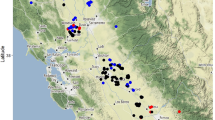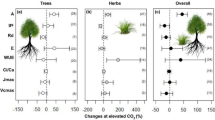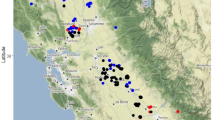Abstract
The global incidence of megafires is on the rise, leading to extensive areas being shrouded in dense smoke for prolonged periods, spanning days or weeks1. Here, by integrating long-term regional observations of non-structural carbohydrate content in trees across California’s Central Valley with spatiotemporal satellite data, we present compelling evidence that dense smoke plumes negatively impact carbohydrate stores in three tree species: Prunus dulcis, Pistacia vera and Juglans regia. Our findings show that the presence of smoke causes a significant decrease in total non-structural carbohydrates, with reductions in the accumulation of both soluble sugar and starch reserves. This decline in carbohydrate levels persists through the trees’ dormancy period into the next season’s bloom, culminating in a reduced yield. Our results highlight a previously unrecognized wildfire threat that could affect plant health and ecosystem stability in both agricultural and natural environments.
This is a preview of subscription content, access via your institution
Access options
Access Nature and 54 other Nature Portfolio journals
Get Nature+, our best-value online-access subscription
$32.99 / 30 days
cancel any time
Subscribe to this journal
Receive 12 digital issues and online access to articles
$119.00 per year
only $9.92 per issue
Buy this article
- Purchase on SpringerLink
- Instant access to full article PDF
Prices may be subject to local taxes which are calculated during checkout




Similar content being viewed by others
Data availability
The AOD data were accessed through Google Earth Engine and are available at https://doi.org/10.5067/MODIS/MCD19A2.061. The climatic data are available from the PRISM Climate Group (https://prism.oregonstate.edu/). For the air quality data, daily mean PM2.5 and daily maximum eight-hour O3 concentrations were collected from https://www.epa.gov/outdoor-air-quality-data. The reported data are available via figshare at https://doi.org/10.6084/m9.figshare.26197214.v1 (ref. 36).
References
Yu, P. et al. Black carbon lofts wildfire smoke high into the stratosphere to form a persistent plume. Science 365, 587–590 (2019).
Turco, M. et al. Anthropogenic climate change impacts exacerbate summer forest fires in California. Proc. Natl Acad. Sci. USA 120, e2213815120 (2023).
Aguilera, R., Corringham, T., Gershunov, A. & Benmarhnia, T. Wildfire smoke impacts respiratory health more than fine particles from other sources: observational evidence from Southern California. Nat. Commun. 12, 1493 (2021).
Gilbert, M. E. & Ripley, B. S. The effect of smoke on the photosynthetic gas exchange of Chrysanthemoides monilifera. S. Afr. J. Bot. 68, 525–531 (2002).
Hoshika, Y. et al. Ozone-induced stomatal sluggishness changes carbon and water balance of temperate deciduous forests. Sci. Rep. 5, 9871 (2015).
Li, L. & Mu, G. Similar effects as shade tolerance induced by dust accumulation and size penetration of particulates on cotton leaves. BMC Plant Biol. 21, 149 (2021).
Li, Y., Wang, Y., Wang, B., Wang, Y. & Yu, W. The response of plant photosynthesis and stomatal conductance to fine particulate matter (PM2.5) based on leaf factors analyzing. J. Plant Biol. 62, 120–128 (2019).
Wittig, V. E., Ainsworth, E. A. & Long, S. P. To what extent do current and projected increases in surface ozone affect photosynthesis and stomatal conductance of trees? A meta-analytic review of the last 3 decades of experiments. Plant Cell Environ. 30, 1150–1162 (2007).
Calder, W. J., Lifferth, G., Moritz, M. A. & St. Clair, S. B. Physiological effects of smoke exposure on deciduous and conifer tree species. Int. J. For. Res. https://doi.org/10.1155/2010/438930 (2010).
Mercado, L. M. et al. Impact of changes in diffuse radiation on the global land carbon sink. Nature 458, 1014–1017 (2009).
Rap, A. et al. Fires increase Amazon forest productivity through increases in diffuse radiation. Geophys. Res. Lett. 42, 4654–4662 (2015).
Yue, X. & Unger, N. Fire air pollution reduces global terrestrial productivity. Nat. Commun. 9, 5413 (2018).
Yue, X. & Unger, N. Aerosol optical depth thresholds as a tool to assess diffuse radiation fertilization of the land carbon uptake in China. Atmos. Chem. Phys. 17, 1329–1342 (2017).
Roderick, M. L., Farquhar, G. D., Berry, S. L. & Noble, I. R. On the direct effect of clouds and atmospheric particles on the productivity and structure of vegetation. Oecologia 129, 21–30 (2001).
Stitt, M. & Zeeman, S. C. Starch turnover: pathways, regulation and role in growth. Curr. Opin. Plant Biol. 15, 282–292 (2012).
Peltier, D. M. P. et al. Old reserves and ancient buds fuel regrowth of coast redwood after catastrophic fire. Nat. Plants 9, 1978–1985 (2023).
Hartmann, H. & Trumbore, S. Understanding the roles of nonstructural carbohydrates in forest trees—from what we can measure to what we want to know. N. Phytol. 211, 386–403 (2016).
Jones, M. W. et al. Global and regional trends and drivers of fire under climate change. Rev. Geophys. 60, e2020RG000726 (2022).
Pan, K. & Faloona, I. C. The impacts of wildfires on ozone production and boundary layer dynamics in California’s Central Valley. Atmos. Chem. Phys. 22, 9681–9702 (2022).
Sperling, O. & Zwieniecki, M. A. Winding up the bloom clock—do sugar levels at senescence determine how trees respond to winter temperature? Tree Physiol. 41, 1906–1917 (2021).
Zwieniecki, M. A., Davidson, A. M., Orozco, J., Cooper, K. B. & Guzman-Delgado, P. The impact of non-structural carbohydrates (NSC) concentration on yield in Prunus dulcis, Pistacia vera, and Juglans regia. Sci. Rep. 12, 4360 (2022).
McDowell, N. G. et al. Mechanisms of woody-plant mortality under rising drought, CO2 and vapour pressure deficit. Nat. Rev. Earth Environ. 3, 294–308 (2022).
McDowell, N. G. Mechanisms linking drought, hydraulics, carbon metabolism, and vegetation mortality. Plant Physiol. 155, 1051–1059 (2011).
O’Brien, M. J., Leuzinger, S., Philipson, C. D., Tay, J. & Hector, A. Drought survival of tropical tree seedlings enhanced by non-structural carbohydrate levels. Nat. Clim. Change 4, 710–714 (2014).
D’Andrea, E. et al. Unravelling resilience mechanisms in forests: role of non-structural carbohydrates in responding to extreme weather events. Tree Physiol. 41, 1808–1818 (2021).
Palácios, R. et al. Evaluation of MODIS Dark Target AOD product with 3 and 10 km resolution in Amazonia. Atmosphere 13, 1742 (2022).
Swain, D. L. A shorter, sharper rainy season amplifies California wildfire risk. Geophys. Res. Lett. 48, e2021GL092843 (2021).
R Core Team R: A Language and Environment for Statistical Computing (R Foundation for Statistical Computing, 2013); https://www.r-project.org/
Dancho, M. & Vaughan, D. anomalize: tidy anomaly detection. R package version 0.2.4 (2023); https://business-science.github.io/anomalize/
Rey-Sanchez, C. et al. AmeriFlux FLUXNET-1F US-Bi2 Bouldin Island corn. AmeriFlux, University of California, Berkeley https://doi.org/10.17190/AMF/1871135 (2022).
Ma, S., Xu, L., Verfaillie, J. & Baldocchi, D. AmeriFlux FLUXNET-1F US-Var Vaira Ranch- Ione. AmeriFlux, University of California, Berkeley https://doi.org/10.17190/AMF/1993904 (2023).
Ma, S., Xu, L., Verfaillie, J. & Baldocchi, D. AmeriFlux FLUXNET-1F US-Ton Tonzi Ranch. AmeriFlux, University of California, Berkeley https://doi.org/10.17190/AMF/2204880 (2023).
Lenth, R. V. emmeans: estimated marginal means, aka least-squares means. R package version 1.8.5 (2023).
Hothorn, T., Bretz, F. & Westfall, P. Simultaneous inference in general parametric models. Biom. J. 50, 346–363 (2008).
Bates, D., Mächler, M., Bolker, B. & Walker, S. Fitting linear mixed-effects models using lme4. J. Stat. Softw. 67, 1–48 (2015).
Orozco, J., Guzmán-Delgado, P. & Zwieniecki, M. A. Lost in the haze: persistent mega-fire smoke exposure jeopardizes tree carbohydrate reserves and yield. figshare https://doi.org/10.6084/m9.figshare.26197214.v1 (2024).
Acknowledgements
We thank Olam Food Ingredients (ofi) for providing yield information. This work was supported by grants from the Almond Board of California (WATER17), the California Pistachio Research Board (PREC8), the California Walnut Board and the California Department of Food and Agriculture (22-0001-020-SF), awarded to M.A.Z. We also thank Google Earth Engine for providing the platform, tools and computational resources necessary for gathering, processing and analysing the satellite data used in this study.
Author information
Authors and Affiliations
Contributions
J.O. and M.A.Z. conceptualized the project. J.O. performed the computations and data visualization and wrote the paper. J.O. and M.A.Z. collected the data. P.G.-D. aided in parts of the data collection. All authors contributed to subsequent paper revisions.
Corresponding author
Ethics declarations
Competing interests
The authors declare no competing interests.
Peer review
Peer review information
Nature Plants thanks Brett Huggett and Drew Peltier for their contribution to the peer review of this work.
Additional information
Publisher’s note Springer Nature remains neutral with regard to jurisdictional claims in published maps and institutional affiliations.
Supplementary information
Rights and permissions
Springer Nature or its licensor (e.g. a society or other partner) holds exclusive rights to this article under a publishing agreement with the author(s) or other rightsholder(s); author self-archiving of the accepted manuscript version of this article is solely governed by the terms of such publishing agreement and applicable law.
About this article
Cite this article
Orozco, J., Guzmán-Delgado, P. & Zwieniecki, M.A. Megafire smoke exposure jeopardizes tree carbohydrate reserves and yield. Nat. Plants 10, 1635–1642 (2024). https://doi.org/10.1038/s41477-024-01819-4
Received:
Accepted:
Published:
Issue date:
DOI: https://doi.org/10.1038/s41477-024-01819-4



